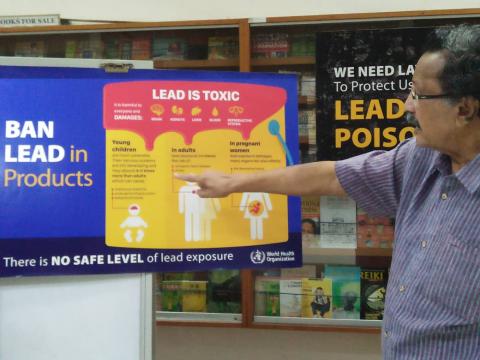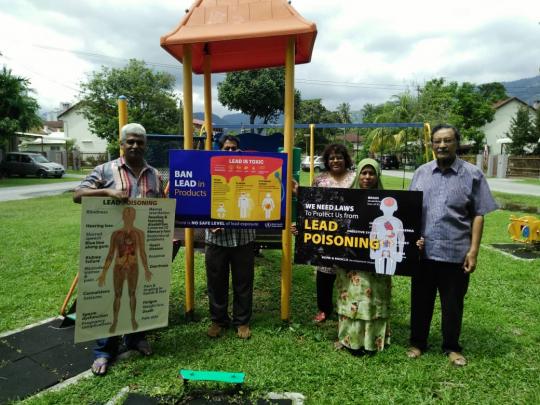CAP Finds Outdoor Play Equipment Coated With Dangerous Levels of Lead

Mr. Mohideen Abdul Kader, CAP President
High levels of lead have been discovered on public playground equipment in the northern region in Malaysia. Painted play equipment containing dangerous levels of lead pose a serious lead poisoning risk to young children. The Consumers’ Association of Penang (CAP) calls for urgent action to prohibit the sale and use of lead paint especially for products that can expose children to lead contamination.
CAP sounds the alarm over lead painted play equipment as the UN-backed INTERNATIONAL LEAD POISONING PREVENTION WEEK OF ACTION [1] is being
observed from October 20-26 with focus on eliminating lead paint.
A survey conducted by CAP which has been documented in a report entitled “Lead in Playground Equipment in Malaysia” finds that 13 out of 17 analysed playground equipment had total lead concentrations above 90 parts per million (ppm), the strictest regulatory standard in the world.
In addition, 11 of such lead-coated playground equipment had dangerously high lead levels above 10,000 ppm.
Prepared in collaboration with IPEN [2] of which CAP is a member, the report highlights the importance of urgent actions to prohibit the production, sale and use of lead paint for all purposes, especially for decoration and coatings on products that can contaminate children’s environment.
The study was undertaken to raise public awareness about the presence of lead paint in children’s playgrounds and persuade the authorities to take decisive actions, including the adoption of lead paint laws and the promotion of safety measures to reduce lead dust hazards when old lead painted play equipment are renovated, repainted or replaced.
CAP detected the lead-coated playground equipment in public playgrounds located in Penang and Kedah using a handheld X-Ray Fluorescence (XRF)
chemical analyzer.
The high levels of lead detected on the paint of outdoor playground equipment are totally worrisome and unacceptable. Over time, the paint will deteriorate with repeated use and exposure to sun and rain. This will cause the paint to peel and get into the dust and soil, which can be ingested by children through common hand-to-mouth behaviour.
Lead is a cumulative toxicant that affects multiple body systems. It is particularly hazardous to young children, pregnant woman and all those that are exposed to it. Effects of exposure include learning disabilities, increased risk of antisocial behaviorur, reduced fertility and increased risk of renal and cardiovascular disease later in life.
The health impacts of lead exposure on young children’s brains are lifelong, irreversible and untreatable.Lead is also introduced into the gastrointestinal tract when children chew on objects such as toys, household furniture or other articles painted with lead paint. Continued use of lead paint is a primary source of childhood lead exposure. Urgent measures need to be taken to reduce critical sources of lead exposure to young children.
Both CAP and IPEN are pushing for the enactment of a mandatory regulation banning lead in paint above the total lead concentration of 90 ppm, the limit recommended in the Model Law and Guidance for Regulating Lead Paint [3], developed by the Global Alliance to Eliminate Lead Paint (GAELP) [4] and published by the UN Environment Programme.
IPEN (International POPs Elimination Network) is a global network of over 500 public interest groups in 121 countries working to reduce and eliminate the harm to human health and the environment from toxic chemicals.
The groups also recommend that the authorities in Malaysia promote the procurement and use of lead-safe paints for painting and maintenance of public playground equipment, facilities, structures, and toys offered to children.
According to the World Health Organization (WHO [5]), lead exposure affects human health, especially for children. There is no known level of lead exposure without harmful effects. Even low levels of lead exposure may cause lifelong health problems. Lead is especially dangerous to children’s developing brains, and can cause reduced intelligence quotient (IQ) and attention span, impaired learning ability, and increased risk of behavioural problems. These health impacts also have significant economic costs to countries.
As stated by Dr. Maria Neira, Director of WHO’s Department of Public Health, Environmental and Social Determinants of Health, “Lead paint represents one of the most widespread sources of lead exposure to infants and children. Yet lead paint still lurks in homes, in schools and on toys. Banning lead paint now can prevent future exposures. This is a very good investment in your health, and in the health of your children.”
The WHO has warned that “childhood lead exposure is estimated to contribute to about 600,000 new cases of children with intellectual disabilities every year.”
Since 1992, CAP has been calling on the government forlaws to eliminate lead in paints. In a test conducted in 1992 we found 7 out of 9 enamel paints contained lead above 600 parts per million. The highest amount of lead found in that study was 11,700 ppm.
In 2016, CAP made another call to the government to set a standard for lead in paint as we found more than 60% of the samples tested contained exceedingly high lead levels. More than three years has passed since then but the Malaysian authorities have not come out with laws on lead in paints.
In view of the dangers of lead CAP calls on the authorities to:
· promulgate laws to eliminate lead in paints
· ban lead in products
· test and ban products that have been found to contain high levels of lead
· run educational campaigns to create awareness on the dangers of lead.
Without a ban Malaysia will be a dumping ground for products with high levels of lead that have been rejected by other countries. As lead has a strong impact on children, immediate actions need to be taken to safeguard our future generation.
Mohideen Abdul Kader
President
Consumers Association of Penang (CAP)
10 Jalan Masjid Negeri
11600 Penang
Tel: 604-8299511
Fax: 604-8298109
Website: consumer.org.my [6]
pengguna.org.my [7]
_______________________________________________________________
Links:
------
[1] https://www.who.int/ipcs/lead_campaign/en/
[2] https://ipen.org/projects/eliminating-lead-paint
[3] https://www.unenvironment.org/resources/publication/model-law-and-guidance-regulating-lead-paint
[4] https://www.unenvironment.org/explore-topics/chemicals-waste/what-we-do/emerging-issues/global-alliance-eliminate-lead-paint
[5] https://apps.who.int/iris/bitstream/handle/10665/326646/WHO-CED-PHE-EPE-19.5-eng.pdf?ua=1
[6] http://consumer.org.my
[7] http://consumer.org.my/
[8] https://groups.google.com/d/msgid/FoE-Malaysia/CAKmmwjaRJ22UR2XW47oLB8ud386Z0C2f0-aaLEN%3D73KgNav2Zw%40mail.gmail.com?utm_medium=email&utm_source=footer

